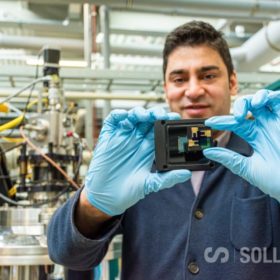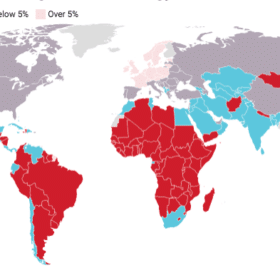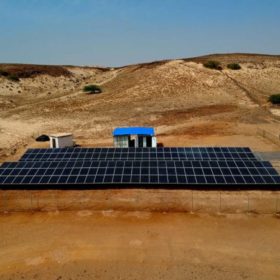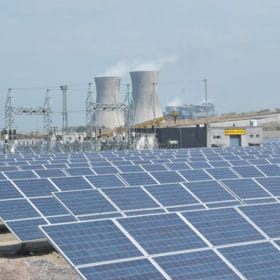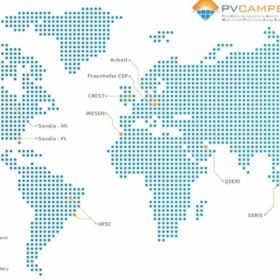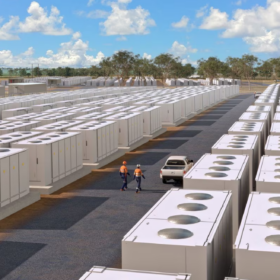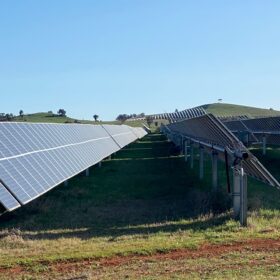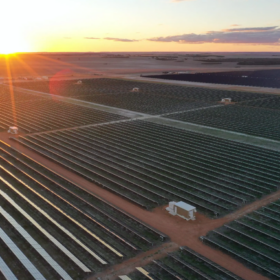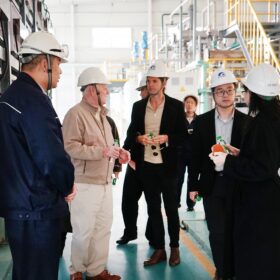Add electric vehicles, not bulk transmission, for a low-cost, clean grid: UC Berkeley study
A 90% clean grid with a transition to EVs would achieve lower electricity costs than one without, the study shows. Transmission investments would mainly be spur lines to new renewable generation.
Solliance hits record efficiency on perovskite/silicon tandem solar cell
The Dutch consortium has achieved the record result by combining, in a four-terminal tandem configuration, an 18.6% efficient highly near-infrared transparent perovskite with a prototype of a c-Si interdigitated back contact (IBC) silicon heteroJunction (SHJ) cell developed by Japanese electronics manufacturer Panasonic. The perovskite cell was also combined with other kinds of solar cells and other remarkable record efficiencies were hit.
Australia ‘in a league of its own’ with renewables potential, positioned to be ‘battery of the world,’ new report finds
Solar and wind could meet the global energy demand 100 times over, a new report from the Carbon Tracker Initiative has found. Australia, in particular, is uniquely positioned to capitalise on the transition as one of the few developed countries with vast renewable potential and a low population.
PV-powered desalination system for water-poor, sun-rich rural areas
Italian start-up Genius Watter has developed a solar desalination solution that is claimed to be particularly suitable for remote areas with no connection to grid electricity. The system is able to produce up to 1,000 cubic meters of potable water per day at an opex of €0.20 per cubic meter.
India’s state utility tenders 1 GW of solar capacity, private company tenders for module partners
Developers have until May 27 to submit bids for state-run power producer NTPC’s projects anywhere in India. In a separate development, company BHEL has issued a global tender seeking module supply partners for an aggregate 750 MW of panels.
Hydrogen overview: recent movements across the globe and at home
Hydrogen is heating up – not only here in Australia, but globally. This week has seen a flurry of news from the U.K. to South Africa, New Dehli to Switzerland. Pv magazine’s roundup of the latest hydrogen news and movements.
Global database for PV system performance
The database brings together photovoltaic performance data and meteorological values from PV systems located in all climate zones. It is being built by an international consortium including the Fraunhofer Centre for Silicon Photovoltaics CSP, and the Anhalt University of Applied Sciences.
Shaded solar parks found to be beneficial for pollinators and plants alike
Researchers in the US ascertained that the partial shading provided by solar parks creates a microclimate that favours the abundant growth of more varied flowers and pollinators. They also found that partial shading increases bloom abundance by delaying bloom timing, increasing forage for pollinators during the hot and dry late season.
Green hydrogen and the cable-pipeline dilemma
New research from Singapore has found that gas pipelines for the onshore transport of green hydrogen and the cables for the transport of electricity to produce it at a distant location have similar costs at a 4000 km transmission distance. For longer distances, gas pipelines were found to be cheaper than cables, although the electric lines are said to benefit from scaling up and higher utilisation. For both options, however, a currently too high hydrogen LCOE remains the biggest barrier to overcome.
First Solar claims lowest module degradation rate in the industry
The US cadmium telluride thin-film module maker said its Series 6 CuRe panels are able to retain 92% of its performance at the end of the 30-year warranty. The improved stability of the product was achieved by eliminating copper and placing Group V elements such as antimony or arsenic onto the tellurium crystal sites.

